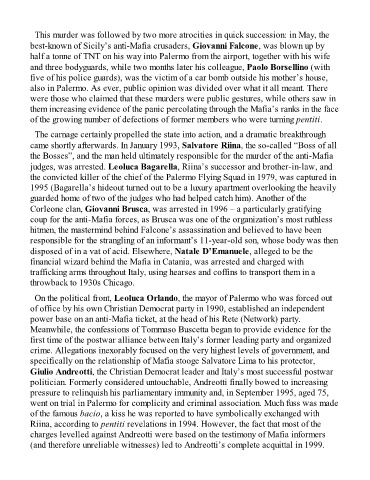Page 580 - The Rough Guide of Sicily
P. 580
This murder was followed by two more atrocities in quick succession: in May, the
best-known of Sicily’s anti-Mafia crusaders, Giovanni Falcone, was blown up by
half a tonne of TNT on his way into Palermo from the airport, together with his wife
and three bodyguards, while two months later his colleague, Paolo Borsellino (with
five of his police guards), was the victim of a car bomb outside his mother’s house,
also in Palermo. As ever, public opinion was divided over what it all meant. There
were those who claimed that these murders were public gestures, while others saw in
them increasing evidence of the panic percolating through the Mafia’s ranks in the face
of the growing number of defections of former members who were turning pentiti.
The carnage certainly propelled the state into action, and a dramatic breakthrough
came shortly afterwards. In January 1993, Salvatore Riina, the so-called “Boss of all
the Bosses”, and the man held ultimately responsible for the murder of the anti-Mafia
judges, was arrested. Leoluca Bagarella, Riina’s successor and brother-in-law, and
the convicted killer of the chief of the Palermo Flying Squad in 1979, was captured in
1995 (Bagarella’s hideout turned out to be a luxury apartment overlooking the heavily
guarded home of two of the judges who had helped catch him). Another of the
Corleone clan, Giovanni Brusca, was arrested in 1996 – a particularly gratifying
coup for the anti-Mafia forces, as Brusca was one of the organization’s most ruthless
hitmen, the mastermind behind Falcone’s assassination and believed to have been
responsible for the strangling of an informant’s 11-year-old son, whose body was then
disposed of in a vat of acid. Elsewhere, Natale D’Emanuele, alleged to be the
financial wizard behind the Mafia in Catania, was arrested and charged with
trafficking arms throughout Italy, using hearses and coffins to transport them in a
throwback to 1930s Chicago.
On the political front, Leoluca Orlando, the mayor of Palermo who was forced out
of office by his own Christian Democrat party in 1990, established an independent
power base on an anti-Mafia ticket, at the head of his Rete (Network) party.
Meanwhile, the confessions of Tommaso Buscetta began to provide evidence for the
first time of the postwar alliance between Italy’s former leading party and organized
crime. Allegations inexorably focused on the very highest levels of government, and
specifically on the relationship of Mafia stooge Salvatore Lima to his protector,
Giulio Andreotti, the Christian Democrat leader and Italy’s most successful postwar
politician. Formerly considered untouchable, Andreotti finally bowed to increasing
pressure to relinquish his parliamentary immunity and, in September 1995, aged 75,
went on trial in Palermo for complicity and criminal association. Much fuss was made
of the famous bacio, a kiss he was reported to have symbolically exchanged with
Riina, according to pentiti revelations in 1994. However, the fact that most of the
charges levelled against Andreotti were based on the testimony of Mafia informers
(and therefore unreliable witnesses) led to Andreotti’s complete acquittal in 1999.

